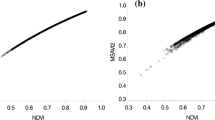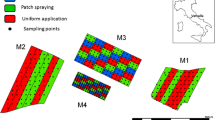Abstract
Unmanned aerial vehicles (UAV) offer interesting alternatives to satellites or airplanes regarding flight agility and image resolution. These sensor platforms may well be used to monitor vines field all throughout the vine’s growing season at a very high spatial resolution. They could provide useful information, different to that normally considered in the literature. To identify the possible uses of UAV images in viticulture, a specific exploratory survey was put into place. This study aimed at identifying (i) relevant information that growers and advisers (G&A) can extract from UAV images and (ii) the added value that this information can have for both G&A’s vineyard management decisions. This approach was conducted on an 11.3 ha commercial vineyard with soil, climate and a training system representative of vineyards in the south of France. UAV-based visible images (25 mm resolution) were acquired every two weeks from budburst to harvest by several UAV companies. Images were shown to a panel of G&As over six sessions during the growing season. Each of these sessions consisted of (i) an individual period during which images were first presented one at a time to each expert and then all together in chronological order from budburst to harvest, and (ii) a collective period during which G&As were asked to share and discuss their point of view. In this exploratory survey, the application of the proposed methodology demonstrated that most of the information on vine status, soil and vineyard environment could be extracted from UAV-based visible images by the experts, thus showing high interest in developing specific image processing techniques to extract this information from images. Results showed that this information was of great interest throughout the growing cycle of the vine, particularly for advisers, as a support to drive management strategies. The outputs of this exploratory study should be confirmed in other contexts than the Languedoc, France region to extrapolate the observed conclusions.





Similar content being viewed by others
References
Andersen, D. F., Vennix, J. A. M., Richardson, G. P., & Rouwette, E. A. J. A. (2017). Group model building: Problem structuring, policy simulation and decision support. Journal of the Operational Research Society, 58(5), 691–694.
Baluja, J., Diago, M. P., Balda, P., Zorer, R., Meggio, F., Morales, F., et al. (2012). Assessment of vineyard water status variability by thermal and multispectral imagery using an unmanned aerial vehicle (UAV). Irrigation Science, 30(6), 511–522.
Benzecri, J. P. (1973). Data analysis, T. 2, The factorial analysys. Paris, France: Ed. Dunod.
Bouadi, T., Cordier, M. O., Moreau, P., Quiniou, R., Salmon-Monviola, J., & Gascuel-Odoux, C. (2017). A data warehouse to explore multidimensional simulated data from a spatially distributed agro-hydrological model to improve catchment nitrogen management. Environmental Modelling & Software, 97, 229–242.
Boulil, K., Pinet, F., Bimonte, S., Carluer, N., Lauvernet, C., Cheviron, B., et al. (2013). Guaranteeing the quality of multidimensional analysis in data warehouses of simulation results: Application to pesticide transfer data produced by the MACRO model. Ecological Informatics, 16, 41–52.
Burgos, S., Mota, M., Noll, D., & Cannelle, B. (2015). Use of very high-resolution airborne images to analyse 3D canopy architecture of a vineyard. International Archives of the Photogrammetry Remote Sensing and Spatial Information Sciences, 40, 399–403.
Comba, L., Gay, P., Primicerio, J., & Aimonino, D. R. (2015). Vineyard detection from unmanned aerial systems images. Computers and Electronics in Agriculture, 114, 78–87.
Coombe, B. G. (1995). Adoption of a system for identifying grapevine growth stages. Australian Journal of Grape and Wine Research, 1, 100–110.
Di Gennaro, S., Battiston, E., Di Marco, S., Facini, O., Matese, A., Nocentini, M., et al. (2016). Unmanned aerial vehicle (UAV)-based remote sensing to monitor grapevine leaf stripe disease within a vineyard affected by esca complex. Phytopathologia Mediterranea, 55(2), 262–275.
Diago, M. P., Pou, A., Millan, B., Tardaguila, J., Fernandes, A. M., & Melo-Pinto, P. (2014). Assessment of grapevine water status from hyperspectral imaging of leaves. Acta Horticulturae, 1038, 89–96.
Drost, E. (2011). Validity and Reliability in social science research. Education Research and Perspectives, 38, 105–124.
Hardie, W. J., & Martin, S. R. (2000). Shoot growth on de-fruited grapevines: A physiological indicator for irrigation scheduling. Australian Journal of Grape and Wine Research, 6(1), 52–58.
Kasbari, M., & Leroux, B. (2016). Methodology for the use of a category E UAV for the detection of flavescence dorée. Cahier des techniques de l’INRA, Mesure et métrologie, 1(2), 30–35.
Matese, A., Primicerio, J., Di Gennaro, F., Fiorillo, E., Vaccari, F. P., & Genesio, L. (2013). Development and application of an autonomous and flexible unmanned aerial vehicle for precision viticulture. Acta Horticulturae, 978, 63–69.
Mathews, A., & Jensen, J. (2013). Visualizing and quantifying vineyard canopy LAI using an unmanned aerial vehicle (UAV) collected high density structure from motion point cloud. Remote Sensing, 5(5), 2164–2183.
Nilakanta, S., Scheibe, K., & Rai, A. (2008). Dimensional issues in agricultural data warehouse designs. Computers and Electronics in Agriculture, 60, 263–278.
Panebianco, S., Pahl-Wostl, C., (2004) Obstacles in Launching a Participatory Group Discussion and Modelling Process. In Pahl, C., Schmidt, S., Rizzoli, A. E, Jakeman, A. J. (Eds.) IEMSs’04. Transactions of the 2nd International Congress on Environmental Modelling and Software, Manno, Switzerland: International Environmental Modelling and Software Society publisher, Vol. 1, pp. 240–246.
Primicerio, J., Caruso, G., Comba, L., Crisci, A., Gay, P., Guidoni, S., et al. (2017). Individual plant definition and missing plant characterization in vineyards from high-resolution UAV imagery. European Journal of Remote Sensing, 50(1), 179–186.
Prosser, J. (1998). Image-based research: A handbook for qualitative researchers. London, UK: Falmer Press.
R Core Team. (2016). R: A language and environment for statistical computing. R Foundation for Statistical Computing, Vienna, Austria. https://www.R-project.org/.
Rey, C., Martin, M. P., Lobo, A., Luna, I., Diago, M. P., Millan, B., et al. (2013). Multispectral imagery acquired from a UAV to assess the spatial variability of a Tempranillo vineyard. In Stafford, J. V. (Ed.) Precision agriculture’13. Proceedings of the 9th European Conference on Precision Agriculture, pp 617–624. Wageningen, The Netherlands: Wageningen Academic Publishers.
Santesteban, L. G., Di Gennaro, S. F., Herrero-Langreo, A., Miranda, C., Royo, J. B., & Matese, A. (2017). High-resolution UAV-based thermal imaging to estimate the instantaneous and seasonal variability of plant water status within a vineyard. Agricultural Water Management, 183, 49–59.
Shadish, W. R., Cook, T. D., & Campbell, D. T. (2002). Experimental and quasi-experimental designs for generalized causal inference. Social Service Review, 76(3), 510–514.
Wacheux, F. (1996). Qualitative methods and research in management. Paris, France: Economica.
Yin, R. K. (2014). Case study research design and methods (5th ed., p. 282). Thousand Oaks, CA, USA: Sage Publications.
Zarco-Tejada, P. J., Guillén-Climent, M. L., Hernández-Clemente, R., Catalina, A., González, M. R., & Martín, P. (2013). Estimating leaf carotenoid content in vineyards using high resolution hyperspectral imagery acquired from an unmanned aerial vehicle (UAV). Agricultural and Forest Meteorology, 171, 281–294.
Acknowledgements
This project was carried out thanks to the support of the company Chair AgroSYS of Montpellier SupAgro (https://www.supagro.fr/wordpress/agrosys/). We thank the Laroche wines winery, part of Advini group, and owner of the vineyards of the study. We also thank the UAV companies Aerotec solution, Atlas, Airinov, Cyleone, Format Drone, Decidrone, and Geofalco for participating in this work without charge.
Author information
Authors and Affiliations
Corresponding author
Additional information
Publisher's Note
Springer Nature remains neutral with regard to jurisdictional claims in published maps and institutional affiliations.
Rights and permissions
About this article
Cite this article
Pichon, L., Leroux, C., Macombe, C. et al. What relevant information can be identified by experts on unmanned aerial vehicles’ visible images for precision viticulture?. Precision Agric 20, 278–294 (2019). https://doi.org/10.1007/s11119-019-09634-0
Published:
Issue Date:
DOI: https://doi.org/10.1007/s11119-019-09634-0




